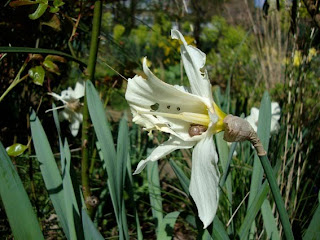The first really warm day has brought everybody out. I can't blame them, it's lovely, but my heart sinks as I see soft young shoots disappear under handbags and behinds. It all seems especially vulnerable this year as everything is out so late due to the long winter. Usually the garden has grown past this point when everyone is still out of harms reach indoors but now, rushing to catch up, the sappy growth is delicate as beansprouts. It will all be fine I'm sure but in the meantime there is lots of silliness to make my blood boil.

As the lunchtime crowd arrive I leave off laying the brick stepping stone path once someone sits immovable on the pile of bricks I am working from - I know, would you? - and retreat to the office to sort out the new plants to go in (special lovelies from the RHS show). A few can be planted in the new south end beds once trespassers are decanted - you would think that this area being fenced off would be clue enough that it is CLOSED - but I am waylaid halfway through when I notice a group happily settling down for lunch to sit along the low wall by the digby jones bench. This wall is mid-bed so trampled under foot are ferns. clematis and ceratostigma. I am direct with my "get out of the flower bed please" and leave them to do just that. Of course five minutes later they are unmoved and I try a different approach.
"hello, where do you work"
"in a bureau"
"do you have a desk"
"yes"
"how about I come to your office, throw everything off your desk and eat my sandwiches on it?"
"what?"
"that's what you are doing - GET OFF THE FLOWER BED!"
They move. I am not calm.
Now, in the photo above, can you see what I see? I have, so go and check. Head and shoulders into the horse-head bed, right on top of the Transylvanian sage, is a collapsed, grubby, swollen-handed, shallow-breathing fellow. There is no response to my repeated rousing "wakey-wakey" so I warily give him a bit of a shake for a minute or so to little effect. Of course as I am watering can in hand the advice of the nearest garden wits is to douse him - this they find very amusing (I am always surprised that people will just unconcernedly eat sandwiches not a cucumber length from an unconscious body). Instead I call for an ambulance. Two paramedics arrive lickety-split and finally get a response with an interesting technique (I won't be trying this anytime in the near future). They recognise him from a similar pick up earlier, his hospital wristband is still on, and think he's probably been rather 'greedy' on release. When the ambulance arrive they are ready to get him up, out and onboard. Hooray! No corpses today.

I have the feeling it will be a silly summer season again but do still manage to notice how well paramedics go with the euphorbias. But then euphorbias do go well with everything.
























